Borneo Lowland Rainforests
The ecoregion’s land area is provided in units of 1,000 hectares. The conservation target is the Global Safety Net (GSN1) area for the given ecoregion. The protection level indicates the percentage of the GSN goal that is currently protected on a scale of 0-10. N/A means data is not available at this time.
Bioregion: Borneo Tropical Forests & Sundaland Heath Forests (IM16)
Realm: Indomalaya
Ecoregion Size (1000 ha):
42,844
Ecoregion ID:
219
Conservation Target:
69%
Protection Level:
1
States: Indonesia, Malaysia, Brunei
This is the land of orangutans, pygmy elephants, and phenomenal zoogeographical patterns that have inspired the British naturalist Alfred Russel Wallace to write the seminal paper ‘On the law which has regulated the introduction of new species’, also known as the ‘Sarawak Law Paper,’ to describe evolution during a collecting trip in the Sarawak in the 1850s. But Wallace was pipped to the post by Charles Darwin when publishing their respective papers on evolution, and is thus now better known for his other writings on natural history and biogeography of the Malay Archipelago, and the Wallace Line that separates the ecozones of Asia and Wallacea,

The flagship species of the Borneo Lowland Rainforests ecoregion is the Sunda clouded leopard. Image credit: Creative Commons
The Borneo Lowland Rainforests ecoregion represents the lowland forests of Borneo. It used to be part of a single landmass that also included Java and Sumatra on the shallow Sunda Shelf, extending from the east-Asian mainland during the Pleistocene glacial period over 12,000 years ago, until subsequent rising sea levels isolated the islands from each other and the mainland. The geology is complex, with a matrix of limestone, volcanic rocks, schist- gneiss complexes, and sedimentary rocks. The climate is tropical, with over 4,000 mm of annual rainfall through the year. Temperatures range between 27 and 32°C, while relative humidity is high at around 80%.
The biodiversity of Borneo’s rainforests is among the richest in the world, rivalling forests of New Guinea and the Amazon. Over 15,000 plant species are known from Borneo— more than that from the whole continent of Africa. The forests are dominated by over 260 species of Dipterocarpaceae, with over 155 endemic to Borneo. The island is widely regarded as the center of species diversity for Dipterocarpaceae and Artocarpus, which includes breadfruit and jackfruit commonly consumed throughout Asia.
Borneo rainforests are multi-layered. The canopy reaches 24 to 36 m in height, with emergent trees towering 65 m, and is dominated by species of Dipterocarpus, Dryobalanops, Shorea, Hopea, Vatica, Burseraceae, and Sapotaceae. The sub-canopy includes species of Euphorbiaceae, Rubiaceae, Annonaceae, Lauraceae, and Myristicaceae, and is usually adorned with lianas, orchids, and epiphytic ferns. Rafflesia arnoldii, one of the six species in this genus of parasitic plants, has the world’s largest flower reaching over 1 meter in diameter. The flowers grow from cryptic vines on the ground and give out the smell of rotten meat to attract insect pollinators.

Rafflesia arnoldii. Image credit: Creative Commons
Since its isolation during the late Pleistocene, the fauna of Borneo has evolved in separation from the mainland and nearby islands, creating a distinct assemblage of Bornean species and sub-species. These include large mammals, such as the Sunda clouded leopard, also the largest carnivore in Borneo, Bornean orangutan, Sumatran rhinoceros, and pygmy elephant, a subspecies of Asian elephant that is much smaller in size than the mainland elephants.
The 11 species of primates clearly reflect the rich faunal diversity in the ecoregion. They include orangutans, gibbons, langurs, macaques, proboscis monkeys, a tarsier, and Bornean slow loris, all of them coexisting in the forests through the partition of habitat, food, and activity times. Over 380 bird species are known from the ecoregion, including eight hornbill species. As in other Asian rainforests, these hornbills play a significant role in seed dispersal and maintaining forest biodiversity.

Sunda clouded leopard. Image credit: Creative Commons
About half the primary forests in this ecoregion has been cleared or degraded, with over 1,300 km2 lost annually. Only 8% of the remaining forest is currently protected, leaving the unprotected forests and their wildlife highly vulnerable to oil palm, rubber, paper and pulp plantations, commercial logging, and hunting. The majority of the ecoregion’s flora and fauna is irreplaceable and has adapted to intact forest habitats. They will not survive these changes.
Thus, the recommended priority conservation actions are to: 1) stop further clearing of intact rainforests for plantations and confine these activities to degraded and underused areas; 2) bring additional forests within a conservation umbrella based on a systematic analysis of biodiversity distribution; and 3) engage indigenous communities in conservation.
Citations
1. Rautner, M., Hardiono, M. and Alfred, R.J., 2005. Borneo: Treasure Island at risk. Status of forest, wildlife and related threats on the island of Borneo. WWF Germany publ.
2. Wikramanayake, E, E. Dinerstein, et al. 2002. Terrestrial Ecoregions of the Indo-Pacific: A Conservation Assessment. Island Press.
3. MacKinnon, K., 1996. The ecology of Kalimantan (Vol. 3). Oxford University Press.



